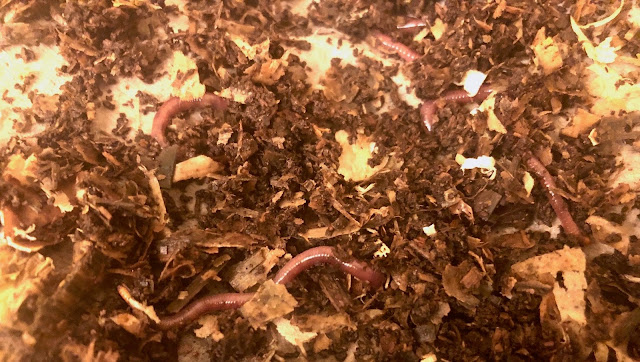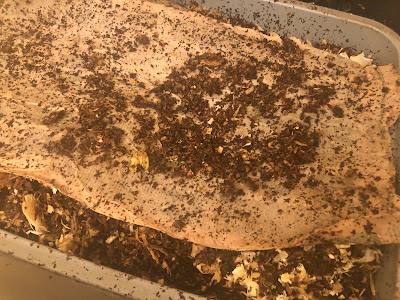

|
|
Red wigglers usually hide from the light, but these are a few brought up from their bedding to the newspaper sheet that holds moisture in their bin. (Photos: Kathy Morrison)
|
Vermicomposting creates garden gold in a small space
Did you know I have worms?
They're cute little red wigglers, and they're working hard in their bin, munching on kitchen scraps and making the world's best soil amendment.
Although I've had a regular compost bin going for about 20 years, I never thought about setting up a worm bin. But I had a class last winter with Sacramento County's most enthusiastic worm wrangler, UCCE master gardener Patty Peterson.
She taught us how to put together a worm bin, an easy process that I'll link to at the end. As luck would have it, I won the bin that my group was putting together. I lugged it home and thought, "Oh great, now I have to keep these worms alive, or risk embarrassing myself with my class."
The bin took a spot outside, in the shade on the north side of my house, with a towel over it to keep it warm in the winter weather. I kept up the food supply, and made sure the bedding stayed moist (but not too moist). The bin started with only 24 tiny worms, and early on whole weeks would go by when I wouldn't see any, or maybe one that had attached itself to the plastic covering.
These worms actually helped keep me sane during the early weeks of the pandemic shutdown. Apple cores and squash peelings were easy food, and I had something else to focus on away from the news.
The worms' bedding began to break down after a few months, so I went to Western Feed & Pet Supply and bought a bale of Eco Flake animal bedding, which is mostly pine shavings. It'll last me a couple of years, I think, but it was worth it.
Gradually the worm population grew, and by the late spring it was thriving. I had no problem spotting at least a few of the residents.

|
|
Here's the worm bin with the top removed, with the newspaper
sheet on the bedding and the photographed worms (above) on top. The bin is in a bathtub now but will go back outside soon. |
When that happens, I intend to harvest most of the castings, and start the process again. And my garden gets the homemade treat.
Worm composting really is the space-efficient way to compost, whether you have a big garden or just a few containers to use the castings in.
And you don't have to take a class with Patty to learn about vermicomposting. She recorded two short videos for Harvest Day over the summer: "Making a Worm Bin" and "Harvesting Worm Castings." The master gardeners also have a great written guide to worm composting, GN 144 .
But I will note a couple of important things here:
-- Use red wigglers ( Eisenia fetida ), the worms sold at bait shops. (They're also available from suppliers online.) These are worms that live in leaf litter. Earthworms that you might see when you dig a hole are different -- they live underground and will quickly escape the bin.
-- The bin shouldn't be deeper than 1 foot, which is why a 10-gallon lidded storage tote is perfect. The master gardeners at the Fair Oaks Horticulture Center have a longer bin built of wood. It's behind Patty in the first video, if you want to see how one looks. The bin should be solid, not clear, and should have holes drilled on all sides and the bottom, for drainage and aeration. It also needs to be set up on bricks or pieces of wood, to allow air underneath. Indoors, it needs a drainage tray (or bathtub!).
-- The worms will devour just about any kitchen plant waste except onions, citrus peels and cranberries. They especially love melon rinds, I've found. I tend to chop up things like banana peels, but that's not crucial. Patty touts worms as perfect pets that don't need sitters: Going on a two-week vacation? Give 'em a pumpkin!
And now I know what to do with that jack o'lantern come Nov. 1.
Comments
0 comments have been posted.Sacramento Digs Gardening to your inbox.
Food in My Back Yard Series
April 22: Should you stock up on fertilizer? (Yes!)
April 15: Grow culinary herbs in containers
April 8: When to plant summer vegetables
April 1: Don't be fooled by these garden myths
March 25: Fertilizer tips: How to 'feed' your vegetables for healthy growth
March 18: Time to give vegetable seedlings some more space
March 11: Ways to win the fight against weeds
March 4: Potatoes from the garden
Feb. 25: Plant a fruit tree now -- for later
Feb. 18: How to squeeze more food into less space
Feb. 11: When to plant? Consider staggering your transplants
Feb. 4: Starting in seed starting
Sites We Like
Garden Checklist for week of April 27
Once the clouds clear, get to work. Spring growth is in high gear.
* Set out tomato, pepper and eggplant transplants.
* From seed, plant beans, beets, cantaloupes, carrots, corn, cucumbers, melons, pumpkins, radishes and squash. Plant onion sets.
* In the flower garden, plant seeds for asters, cosmos, celosia, marigolds, salvia, sunflowers and zinnias. Transplant petunias, zinnias, geraniums and other summer bloomers.
* Plant perennials and dahlia tubers for summer bloom. Late April is about the last chance to plant summer bulbs, such as gladiolus and tuberous begonias.
* Transplant lettuce and cabbage seedlings.
* Weed, weed, weed! Don’t let unwanted plants go to seed.
* April is the last chance to plant citrus trees such as dwarf orange, lemon and kumquat. These trees also look good in landscaping and provide fresh fruit in winter.
* Feed citrus trees with a low dose of balanced fertilizer (such as 10-10-10) during bloom to help set fruit. Keep an eye out for ants.
* Apply slow-release fertilizer to the lawn.
* Thoroughly clean debris from the bottom of outdoor ponds or fountains.
* Start thinning fruit that's formed on apple and stone fruit trees -- you'll get larger fruit at harvest (and avoid limb breakage) if some is thinned now. The UC recommendation is to thin fruit when it is about 3/4 of an inch in diameter. Peaches and nectarines should be thinned to about 6 inches apart; smaller fruit such as plums and pluots can be about 4 inches apart. Apricots can be left at 3 inches apart. Apples and pears should be thinned to one fruit per cluster of flowers, 6 to 8 inches apart.
* Azaleas and camellias looking a little yellow? If leaves are turning yellow between the veins, give them a boost with chelated iron.
* Trim dead flowers but not leaves from spring-flowering bulbs such as daffodils and tulips. Those leaves gather energy to create next year's flowers. Also, give the bulbs a fertilizer boost after bloom.
* Pinch chrysanthemums back to 12 inches for fall flowers. Cut old stems to the ground.
* Mulch around plants to conserve moisture and control weeds.